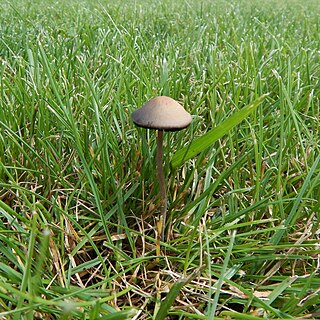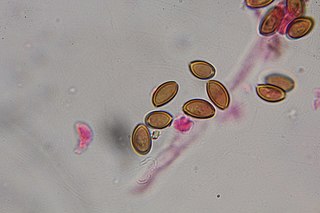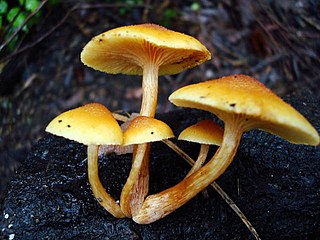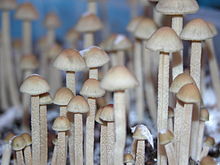Description
The cap is 1.5 — 2(2.5) cm and hemispheric to convex to companulate. The margin is incurved when young, clay-colored, often reddish brown towards the disc, hygrophanous, smooth, and grayish to greenish; it is translucent-striate at the margin when wet. It becomes blue when bruised.
The gills are adnexed, distinctly mottled, and dully grayish with blackish spots.
The stipe is 5–12 cm long, 2–3 mm thick, hollow, and vertically striate. It is blackish towards the base, greyish towards the apex, and pallid to whitish fibrils run the length of the stipe. The stipe is equal to slightly swollen at the base and lacks a partial veil.
Panaeolus tropicalis spores are dark violet to jet black, ellipsoid, and 10.5–12.0 x 7–9 µm. The basidia each produce two spores.
Like many other hallucinogenic mushrooms, this fungus readily bruises blue where it is handled. It can be differentiated from Panaeolus cyanescens by microscopic characteristics.

Psilocybe azurescens is a species of psychedelic mushroom whose main active compounds are psilocybin and psilocin. It is among the most potent of the tryptamine-bearing mushrooms, containing up to 1.8% psilocybin, 0.5% psilocin, and 0.4% baeocystin by dry weight, averaging to about 1.1% psilocybin and 0.15% psilocin. It belongs to the family Hymenogastraceae in the order Agaricales.

Panaeolus cinctulus, syn. Panaeolus subbalteatus, commonly known as the banded mottlegill, weed Panaeolus, belted panaeolus, or subbs is a very common, widely distributed psilocybin mushroom. According to American naturalist and mycologist David Arora, Panaeolus cinctulus is the most common psilocybin mushroom in California.

Panaeolus is a genus of small, black-spored, saprotrophic agarics. The word Panaeolus is Greek for "all variegated", alluding to the spotted gills of the mushrooms produced.

Pluteus is a large genus of fungi with over 300 species. They are wood rotting saprobes with pink spore prints and gills that are free from the stem.

Inocybe aeruginascens is a member of the genus Inocybe which is widely distributed in Europe. The species was first documented by I. Ferencz in Ócsa, Hungary on June 15, 1965.

Panaeolina is a small genus of small mushrooms, containing only about four species. They are a subgroup of Panaeolus which have dark brown spores. The type species is Panaeolina foenisecii, a common lawn mushroom. Members of Panaeolina are broadly distributed throughout the world.

Panaeolus cyanescens, commonly known as the blue staining panaeolus, is a mushroom in the Bolbitiaceae family. Panaeolus cyanescens is a common psychoactive mushroom and is similar to Panaeolus tropicalis.
Panaeolus africanus is a little brown mushroom that contains irregular amounts of the hallucinogens psilocybin and psilocin. It has been found in central Africa and southern Sudan.

Panaeolus bisporus, also known as Copelandia bisporus is a rare and widely distributed little brown mushroom that bruises blue and contains the hallucinogen psilocybin.

Panaeolus olivaceus is a widely distributed, seldom identified, little brown mushroom that contains the hallucinogen psilocybin; it is often mistaken for Panaeolus foenisecii and is distinguished by its black spore print and darker gill coloration when mature alongside a slightly thicker stem. It is even more easily mistaken for Panaeolus cinctulus or Panaeolus fimicola and can be distinguished from them both by its slightly roughened spores. It is also easily confused with Panaeolina castaneifolia, a species which has spores that are dark brown and significantly more roughened.

Panaeolus fimicola is a widespread but seldom identified "little brown mushroom" which sometimes contains small amounts of the hallucinogen psilocybin. Panaeolis ater is a synonym. The species is also referred to as the "turf mottlegill".

Panaeolus foenisecii, commonly called the mower's mushroom, haymaker, haymaker's panaeolus, or brown hay mushroom, is a very common and widely distributed little brown mushroom often found on lawns and is not an edible mushroom. In 1963 Tyler and Smith found that this mushroom contains serotonin, 5-HTP and 5-hydroxyindoleacetic acid. In many field guides it is listed as psychoactive; however, the mushroom does not produce any hallucinogenic effects.

Panaeolus papilionaceus, also known as Agaricus calosus, Panaeolus campanulatus, Panaeolus retirugis, and Panaeolus sphinctrinus, and commonly known as Petticoat mottlegill, is a very common and widely distributed little brown mushroom that feeds on dung.

Psilocybe strictipes is a mushroom that grows on grassy meadows and lawns; It is found throughout the cool temperate and subarctic regions of the Northern Hemisphere and it is most common in Europe, and the Pacific Northwest region of North America. It contains the psychoactive compound psilocybin is closely related to Psilocybe semilanceata and Psilocybe pelliculosa. Psilocybe strictipes is commonly confused with Psilocybe semilanceata and can be differentiated by its lack of a papilla and a convex to subumbonate cap. "Strictipes" comes from the Latin words stricti (narrow) and pes (foot).

Psilocybe caerulescens, also known as landslide mushroom, is a psilocybin mushroom having psilocybin and psilocin as main active compounds. Along with Psilocybe mexicana and Psilocybe aztecorum, it is one of the mushrooms likely to have been used by the Aztecs and is currently used by Mazatec shamans for its entheogenic properties.

Gymnopilus luteoviridis is a widely distributed mushroom-forming fungus of the Eastern United States that contains the hallucinogens psilocybin and psilocin.

Gymnopilus braendlei is a species of agaric fungus in the family Hymenogastraceae that contains the hallucinogens psilocybin and psilocin. It was originally described by mycologist Charles Horton Peck as Flammula braendlei, from specimens found in the District of Columbia in 1902.

Agaricus perobscurus, commonly known collectively with its close European relative Agaricus lanipes as the princess, is a basidiomycete fungus. A relative of Agaricus augustus, known as the prince, A. perobscurus can be differentiated in several aspects. While the prince is widely distributed in North America, the princess is found only in the San Francisco Bay Area. Besides its smaller size, it is distinguished from Agaricus augustus by a darker-brown cap, a patchy fibrillose stipe surface at youth, lacking densely floccose-scaly, and a different fruiting season. Another commonly closely associated Agaricus species, Agaricus praeclaresquamosus, is toxic. It can be differentiated by its dark-grey cap, a phenolic, rather than an anise odor, and a stipe base which yellows immediately when injured.
Panaeolus microsporus is a species of mushroom in the Bolbitiaceae family. It is a psychoactive species of the Panaeolus genus, containing alkaloids like psilocybin and psilosin. All Panaeolus species produce serotonin and serotonin derivatives.
Panaeolus lentisporus is a species of psychoactive mushroom belonging to the genus Panaeolus, and classified under the family Bolbiteacea. It is native to Papua New Guinea and some parts of Asia. The fungus was first described by E. Gerhardt in 1996. It is very similar to Panaeolus affinis, and should not be confused with it.

















